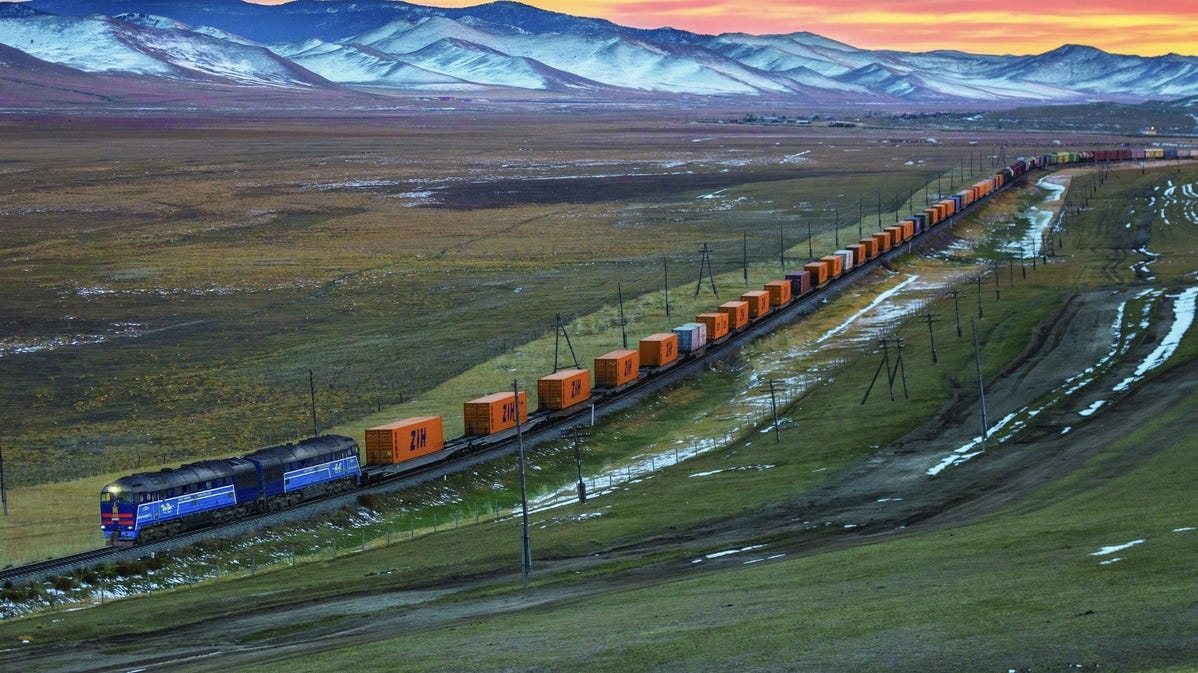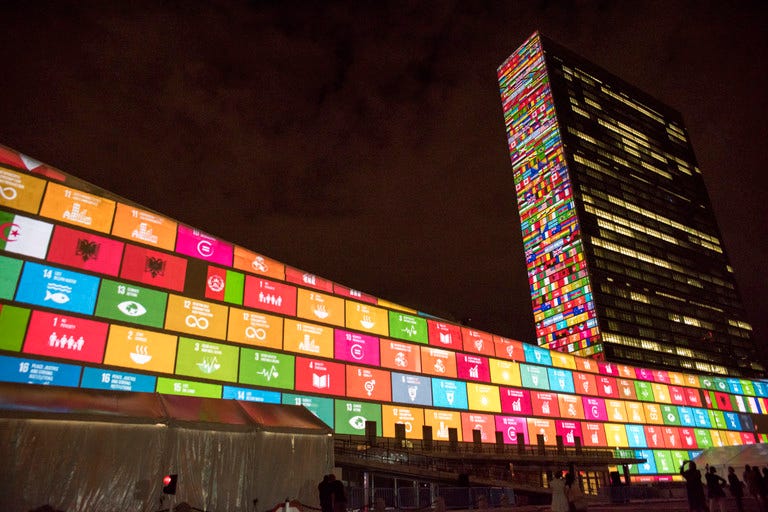👏 What to expect from Global Development Initiative?
The GDI reminds the int'l community of the pressing need for development, and advocates for strengthening global development partnership .

Development holds the key to people's well-being. -- Chinese President Xi Jinping
Since its inception one year ago, the Global Development Initiative (GDI) has become a catch-phrase in the international arena, with more than 100 countries having expressed their support to date.
Here are some key points sorted out from China's official documents and research reports, which may help those who are interested to keep up with this fresh initiative.
WHAT IS GDI?
The GDI was proposed by Chinese President Xi Jinping at the General Debate of the 76th Session of the United Nations General Assembly in 2021. It aims to steer global development toward a new stage of balanced, coordinated and inclusive growth.
Under the GDI, China has called on the world to stay committed to development as a priority, to a people-centered approach, to benefits for all, to innovation-driven development, to harmony between man and nature, and to action-oriented approaches.
Eight key areas have been listed for practical cooperation including poverty reduction, food security, COVID-19 and vaccines, financing for development, climate change and green development, industrialization, digital economy, and connectivity.

WHY WAS GDI PROPOSED?
As changes of the times combine with the once-in-a-century COVID-19 pandemic, the world finds itself in a new period of turbulence and transformation with increasing instability and uncertainty.
The pandemic severely disrupts gains in poverty alleviation. Global crises such as food insecurity, refugee and climate change are worsening. The North-South development gap keeps widening. Global economic recovery faces strong headwinds. Global development deficit grows.
The world has moved "tremendously off track" in meeting the globally agreed-upon deadline set by the 2030 Agenda to achieve Sustainable Development Goals (SDGs), said UN Secretary-General Antonio Guterres.
In response to the call of the times, China hopes to cement consensus in the international community to explore a viable path to accelerating the implementation of the 2030 Agenda.
DOES GDI SEEK TO REPLACE EXISTING FRAMEWORKS?
The GDI seeks synergy with existing mechanisms, and is intended neither to replace existing international development agenda nor to dilute the 2030 Agenda or cherry-pick the SDGs, according to the Global Development Report issued by the Center for International Knowledge on Development.
It is intended to renew focus on development issues, to re-commit to the SDGs, to revitalize global partnership, and to reactivate international development cooperation, the report said.
The GDI reminds the international community of the pressing need for development, and advocates for strengthening global development partnership and forging international synergy to effectively address the challenges posed by COVID-19, and help developing countries accelerate their recovery and achieve the SDGs on schedule.
The GDI will align itself with development cooperation strategies of all parties, in particular the Agenda 2063 of the African Union, the Association of Southeast Asian Nations (ASEAN) 2025, the New Partnership for Africa's Development, and the Initiative on Partnership for Africa's Development, among others. It promotes synergy and mutual support among development processes of all countries, regions and mechanisms.
The GDI will join forces with existing multilateral mechanisms and platforms to strengthen effective actions on all 17 SDGs. This includes forming synergies with multilateral, regional, and sub-regional mechanisms, such as the UN, Asia-Pacific Economic Cooperation, G20, BRICS, SCO, and "10+1", and encouraging international organizations, governments, businesses, and the academia to play their roles in the symphony of implementing the 2030 Agenda.
HOW IS GDI DIFFERENT FROM BRI?
The GDI has direct and deep relevance with the Belt and Road Initiative (BRI), as both are major public goods proposed by China for the world. The two initiatives are committed to promoting mutually beneficial international cooperation but self-contained with different focuses.
At present, the GDI emphasizes the battle against COVID-19 and economic recovery, with its focus on the most pressing issues currently facing humanity, such as poverty reduction, food security, and COVID-19 response.
In the mid- to long-term, the GDI strives to complete the 2030 Agenda through concrete actions.
The BRI, on the other hand, points to a longer-term future. It focuses on five major cooperation areas: policy coordination, facilities connectivity, unimpeded trade, financial integration, and people-to-people bonds.
Compared with the BRI, which gives weight to infrastructure investment, more sharing of development experience and knowledge can be expected from the GDI, analysts said.
In brief, the GDI and the BRI serve as practical platforms for building a community with a shared future for mankind -- the GDI emphasizes completing the 2030 Agenda for Sustainable Development, while the BRI focuses on international economic cooperation on a larger scale, in greater depth, and over a longer span of time, according to a report from the Academy Contemporary China and World Studies.

WHAT HAS BEEN ACHIEVED UNDER GDI FRAMEWORK?
In January 2022, the Group of Friends of the GDI was launched at the UN, and over 60 countries have joined the group so far.
The total population of the 60 countries reaches 3.496 billion, accounting for 44.39% of the world's total. Their combined GDP hits around 27.61 trillion U.S. dollars, accounting for 28.73% of the global total. Their foreign trade volume comes in at 14.43 trillion U.S. dollars, accounting for around half of the world's total.
The initiative is only a year old, but it is already bearing fruit. Here is a list of what China has done.
**Capital resources**
In January 2022, China launched Phase III of the FAO-China South-South Cooperation Trust Fund with a total amount of 50 million U.S. dollars, providing considerable resources for international cooperation in poverty reduction and food security.
In October 2021, the 2030 Agenda for Sustainable Development Sub-Fund of the UN Peace and Development Trust Fund established by China approved new projects on green transition, digital technology, and capacity building in scores of countries in the Asia-Pacific, Africa, Latin America and the Caribbean, taking into consideration the real development needs of developing countries.
At the High-level Dialogue on Global Development hosted in Beijing in June, Xi said China will upgrade the South-South Cooperation Assistance Fund to a Global Development and South-South Cooperation Fund, add 1 billion U.S. dollars to the fund on top of the 3 billion dollars already committed, and increase input to the UN Peace and Development Trust Fund.
**Environmental protection**
In January 2022, China and the International Union for Conservation of Nature and other relevant international organizations successfully held the World Coastal Forum to form an international exchange platform for global coastal protection and migratory bird protection.
In February, the China-Pacific Island Countries Climate Action Cooperation Center was inaugurated to support relevant countries in enhancing their capacity to cope with climate change and carry out relevant studies.
**Poverty alleviation**
In October 2021, China held the Global Rural Development Forum to promote exchanges and cooperation in poverty reduction and rural development.
In March, China co-organized a seminar program with the United Nations Office for South-South Cooperation. The program has trained over 1,000 people from nearly 100 countries on cross-border e-commerce.
China has also worked with the World Food Programme to provide food aid to Uganda, Zimbabwe, and East Timor.
**Medical services**
By the end of March 2022, China had provided around 2.2 billion doses of COVID-19 vaccines to more than 120 countries and international organizations.
China will continue to carry out "small but beautiful" free medical treatment activities in developing countries, and build cooperation mechanisms between Chinese and African hospitals. By 2030, the country will send 5,000 medical team members to developing countries in need to enhance their capacity to fight COVID-19 and build medical services.
**Sharing of development knowledge and experience**
In March 2022, China's Ministry of Finance, the Development Research Center of the State Council, and the World Bank launched a joint study report titled Four Decades of Poverty Reduction in China: Drivers, Insights for the World, and the Way Ahead. The report analyzed the key drivers of China's poverty reduction over the past 40 years and took stock of the takeaways in China's experience for other developing countries.
In May, the Secretariat of China-ASEAN Knowledge Network for Development was officially launched. The Network aims to share development knowledge and development opportunities, to provide intellectual support for building the China-ASEAN community with a shared future, and to support the implementation of the GDI and the 2030 Agenda.
Going forward, China will set up a platform for experience and knowledge sharing on international development, a global development promotion center and a global knowledge network for development, for the purpose of exchanging governance experience and promoting mutual learning.
The country will also host a global forum on youth development and take part in the launch of a global action plan on youth development, in a bid to pool as much strength as possible for the implementation of the 2030 Agenda for Sustainable Development.










![[Photo:amchamchina.org] [Photo:amchamchina.org]](https://substackcdn.com/image/fetch/$s_!IocK!,w_1456,c_limit,f_auto,q_auto:good,fl_progressive:steep/https%3A%2F%2Fbucketeer-e05bbc84-baa3-437e-9518-adb32be77984.s3.amazonaws.com%2Fpublic%2Fimages%2Fb166ace3-5a1a-4c8a-a1fe-1e6556ba3f56_600x248.bmp)

Excellent summary.
My takeaway is that the GDI and the BRI are the platforms on which China is building a community with a shared future for mankind.
Many thanks for clarifying that.
Thanks for reading and the great content you regularly share here on your newsletter.